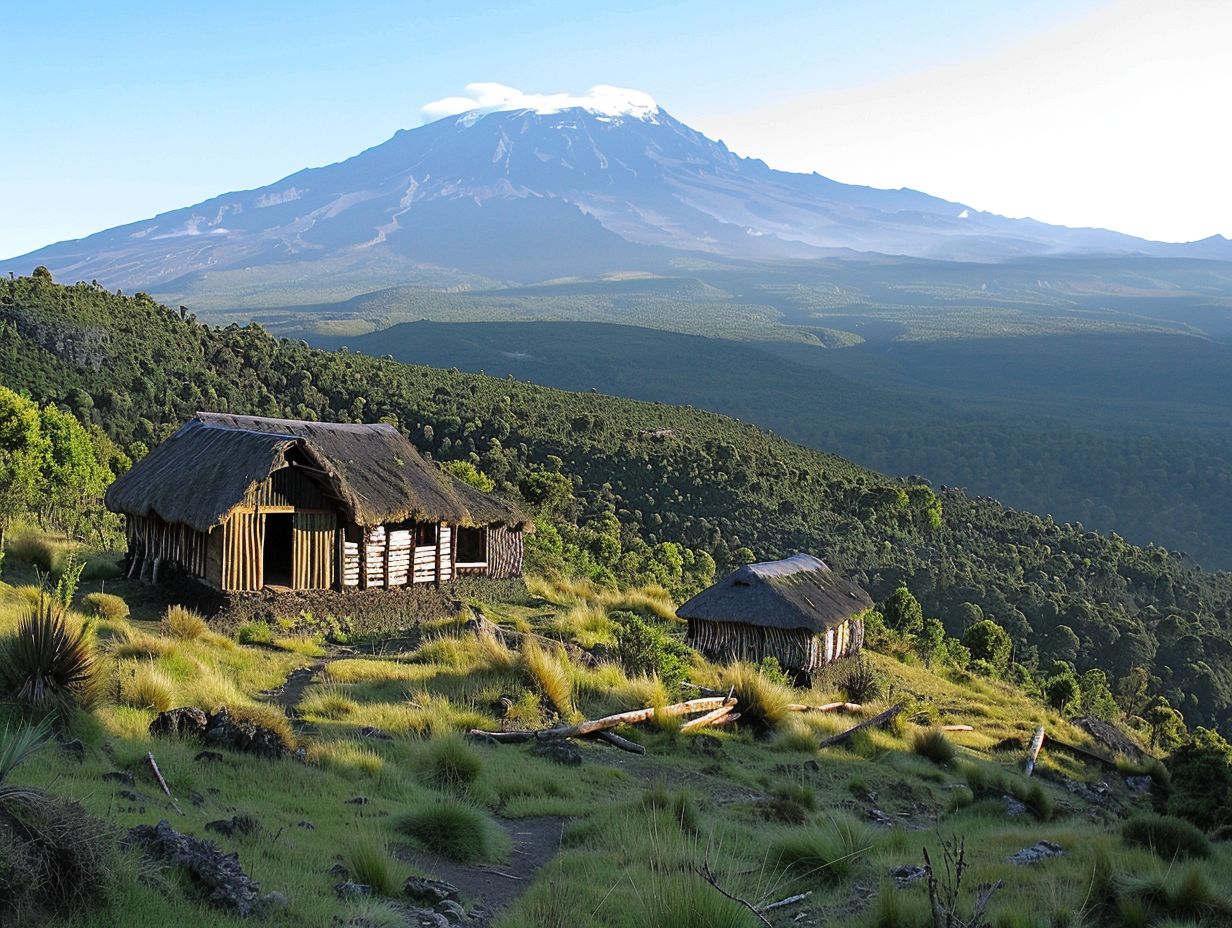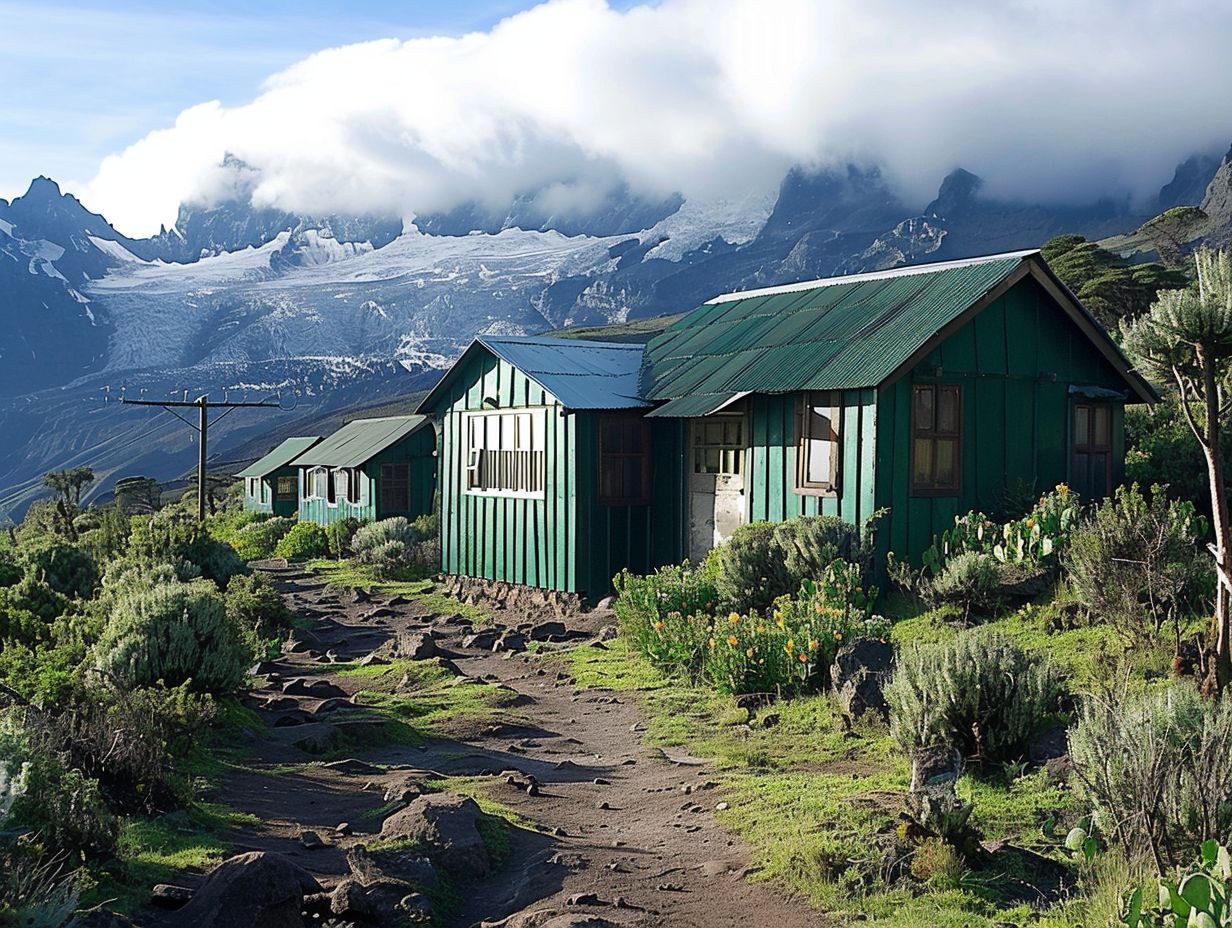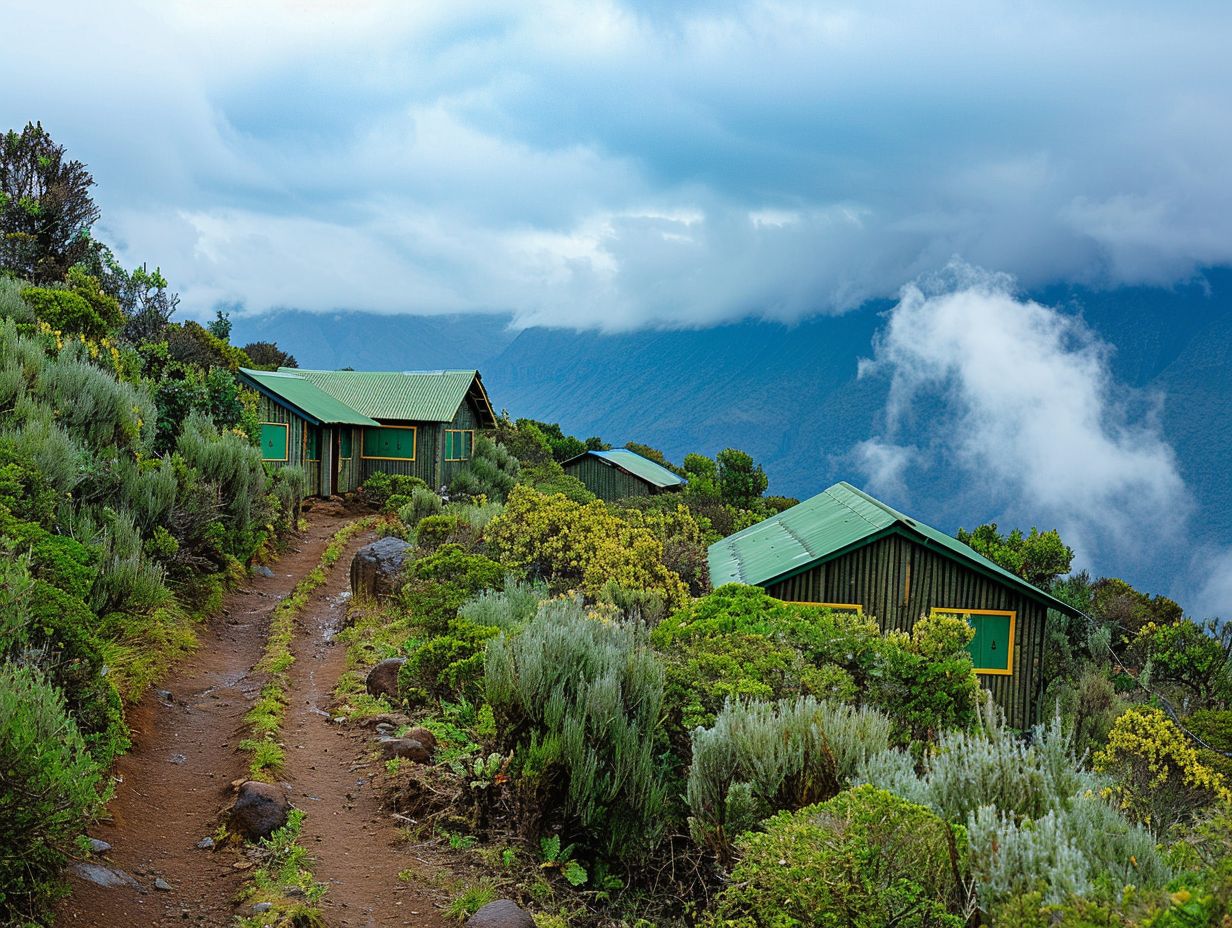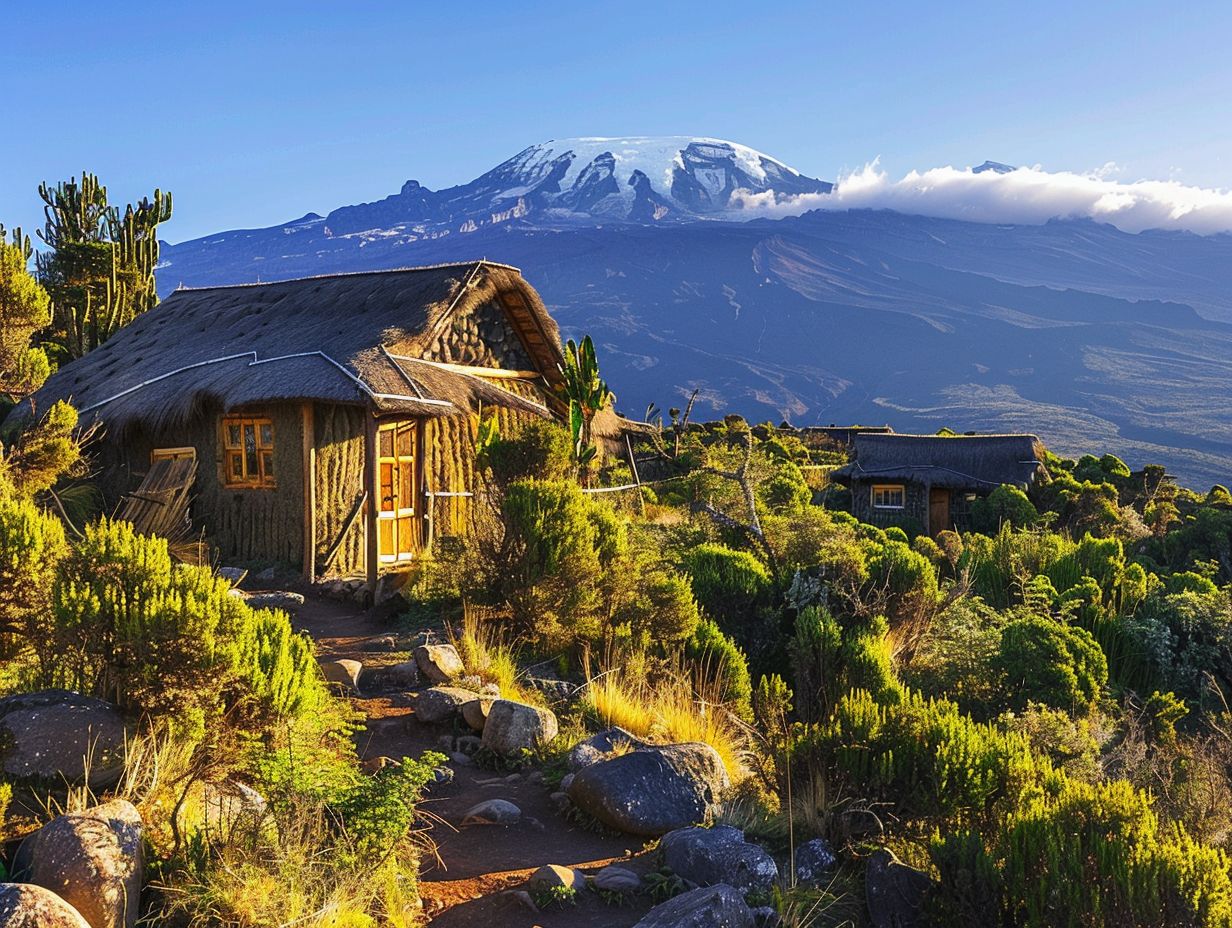
Have you ever wondered about the huts on the Kilimanjaro Marangu Route? From Mandara Hut to Kibo Hut, each one offers unique facilities and accommodations for trekkers on their journey to the summit.
Here, we will explore what you can expect at these huts, including sleeping arrangements, dining areas, and more. Find out what essential items you need to bring for your stay and get ready for an adventure unlike any other.
Join us as we uncover the secrets of the Kilimanjaro Route huts!
Key Takeaways:

- The Kilimanjaro Marangu Route has three huts – Mandara, Horombo, and Kibo – for overnight accommodations during the climb.
- The huts offer basic facilities such as sleeping arrangements, dining area, toilets, water source, and limited electricity.
- Climbers should bring essential items like a sleeping bag, personal toiletries, headlamp, water bottle, and snacks for their stay at the huts.
What are the Huts on Kilimanjaro Marangu Route?
The Marangu Route on Kilimanjaro is dotted with essential huts that serve as vital rest points for climbers. These huts offer shelter and respite along the challenging journey to the summit of Mount Kilimanjaro.
Starting with Mandara Hut, located at around 2,700 meters above sea level, it is the initial stop on the Marangu Route. The hut’s design embraces the traditional Chagga architecture, providing a glimpse into local culture.
Moving on to Horombo Hut at 3,720 meters, it stands out with its stunning views of the surrounding landscapes and the distant Uhuru Peak.
The strategic location of Kibo Hut, the final resting point before the summit at about 4,700 meters, marks the crucial transition into the alpine desert zone, preparing climbers for the ultimate ascent.
Mandara Hut
Mandara Hut is the first overnight stop for climbers on the Marangu Route up Kilimanjaro. Situated in a lush rainforest setting, this hut provides a cozy resting place for trekkers after their initial day of climbing.
Surrounded by towering trees and vibrant flora, Mandara Hut offers a unique experience in the heart of nature. The accommodations consist of simple yet comfortable bunk beds in shared dormitories, allowing climbers to rejuvenate before continuing their ascent.
Trekkers can gather in the communal dining area to refuel with hearty meals, prepared by skilled cooks. The hut’s strategic location along the Marangu Route offers a convenient starting point for the challenging journey ahead, with scenic views of the lush vegetation and surrounding peaks.
Horombo Hut
Horombo Hut is a crucial acclimatization point on the Marangu Route, offering climbers a chance to adjust to the altitude. Nestled in the alpine zone, this hut provides stunning views and necessary rest for the ascent.
At an altitude of around 3,720 meters, Horombo Hut acts as a pivotal stopover during the climb, allowing trekkers to acclimatize to the thinning air before advancing further. The landscape surrounding the hut is dotted with unique flora and fauna, including giant groundsels and lobelias, adding to the charm of the acclimatization process.
Climbers spend a night or two at Horombo Hut, engaging in light walks in the daytime to assist in adjusting to the increasing altitude. This gradual ascent not only enhances physical adaptation but also plays a vital role in reducing the risks of altitude sickness.
Kibo Hut
Kibo Hut is the final overnight stop before the summit push to Uhuru Peak on Kilimanjaro. Positioned near the peak, this hut marks a critical stage in the climb, testing climbers’ determination and resilience.
Kibo Hut serves as a pivotal resting point, allowing climbers to acclimatize to the challenging altitude and extreme weather conditions before their final ascent. At this altitude, every step becomes tougher, as the air thins and temperatures drop. Climbers face not only physical challenges but also mental hurdles, pushing past exhaustion and high altitude fatigue.
The journey from Kibo Hut to Uhuru Peak is grueling, demanding mental fortitude and physical endurance. Adequate preparation is paramount, emphasizing a thorough acclimatization process, physical fitness, and mental readiness.
What are the Facilities at the Huts?
The huts along the Marangu Route on Kilimanjaro offer essential facilities to support climbers during their trek. These include sleeping arrangements, dining areas, toilets, water sources, and limited electricity.
Each hut typically provides bunk beds or sleeping platforms with mattresses or sleeping pads, offering a comfortable rest area for climbers after a day of trekking. The dining areas are equipped with basic cooking facilities or food services to provide nourishing meals for the climbers. Toilet facilities consist of simple pit latrines or eco-friendly composting toilets to ensure hygiene and sanitation along the route.
Water sources near the huts allow climbers to replenish their supplies or refill containers for drinking and cooking purposes. While electricity access is limited, some huts may have solar-powered lights or charging stations for essential devices such as phones or cameras.
Sleeping Arrangements
Sleeping arrangements in the huts on Kilimanjaro cater to climbers’ essential rest needs. Each hut provides bunk beds or sleeping mats for trekkers to recharge after a challenging day of climbing.
Some huts offer bunk beds with mattresses for added comfort, while others provide simple sleeping mats for a more rustic experience. Climbers can use their own sleepings bags or rent them from the huts, ensuring a cozy night’s sleep amidst the high-altitude adventure.
Rest is crucial during the climb as it allows the body to recover and acclimatize to the changing altitude levels, enabling climbers to perform better and reduce the risk of altitude-related illnesses.
Dining Area

The dining areas at the huts serve as communal spaces where climbers can refuel with hearty meals. These areas provide a social setting for trekkers to share experiences and bond over their Kilimanjaro adventure.
Most huts offer buffet-style meals with a variety of options, including local favorites and international dishes. Climbers can indulge in freshly cooked delicacies that cater to different dietary needs, ensuring everyone has a satisfying meal after a long day of trekking.
The rustic charm of the dining areas creates a cozy atmosphere, perfect for relaxing and chatting with fellow climbers about the challenges and triumphs of their ascent.
Toilets
Toilets at the huts on Kilimanjaro are basic facilities that ensure climbers’ hygiene and comfort during their trek. The limited toilet resources highlight the importance of responsible usage by all trekkers.
These toilet facilities may vary in cleanliness and maintenance, with some huts offering composting toilets that promote eco-friendly practices. Trekkers are encouraged to follow proper toilet etiquette, such as not throwing trash down the toilet and using provided toilet paper sparingly.
Hygiene practices are crucial to prevent the spread of illnesses and maintain the pristine environment of Kilimanjaro. It’s essential for climbers to adhere to guidelines and respect the facilities to ensure a pleasant experience for all.”
Water Source
Water sources near the huts are vital for climbers to stay hydrated and safe during their ascent on Kilimanjaro. Trekkers are advised to refill their water bottles at designated points to ensure an adequate supply.
Availability of water sources near the huts is crucial for climbers embarking on the challenging journey up Kilimanjaro, the highest peak in Africa. These sources, typically ranging from natural springs to filtered taps, provide a lifeline for trekkers facing the harsh mountain environment.
Hydration plays a pivotal role in maintaining physical performance and acclimatizing to high altitudes. Water not only combats altitude sickness but also regulates body temperature, preventing exhaustion.
To safeguard against dehydration, climbers must adhere to proper hydration practices while trekking. It is essential to consume water consistently throughout the day, even if not feeling thirsty. Safety measures include carrying an adequate amount of water, usually around 3-4 liters per day, and staying vigilant about refilling at every available opportunity.
Climbers should also be mindful of the quality of water sources, opting for purified or treated water whenever possible to prevent waterborne illnesses. Recognizing the signs of dehydration, such as dizziness or dark urine, is crucial in maintaining overall health and well-being during the climb.
Electricity
Limited electricity is available at the huts on Kilimanjaro for essential lighting and charging needs. Climbers can utilize this power source sparingly to ensure shared access among trekkers.
With the demanding conditions of the climb, having electricity at the huts offers a significant convenience for climbers. The lighting provided not only illuminates the living spaces after dark but also enhances safety for navigating around the campsite.
The ability to charge devices like headlamps, GPS trackers, or cameras ensures that climbers can stay connected and capture memories along the journey.
Responsible consumption of electricity is crucial for maintaining sustainable energy practices on Kilimanjaro. By being mindful of their energy usage, climbers can contribute to preserving the natural environment and reducing their carbon footprint. This awareness fosters a culture of respect for the resources available, encouraging trekkers to appreciate the delicate balance between modern conveniences and eco-friendly habits.
What to Expect at the Huts?
The huts on Kilimanjaro Marangu Route offer basic accommodations and shared spaces for climbers to rest and recuperate. Trekkers can expect limited resources but stunning natural surroundings during their stay.
These huts, situated strategically along the trail, provide not only shelter but also a sense of community among fellow climbers. With cozy sleeping quarters equipped with simple beds and blankets, they offer a much-needed respite after a challenging day of trekking.
- Shared dining areas allow climbers to share stories over hearty meals, fostering camaraderie among adventurers from all walks of life.
- The huts also feature communal bathrooms with basic amenities, ensuring a level of comfort amidst the rustic surroundings of the mountain.
Despite the simplicity of the accommodations, the stunning vistas of the surrounding landscapes, including lush forests and sweeping vistas of the African plains, make every moment spent at these huts truly unforgettable.
Basic Accommodations
Basic accommodations at the huts provide climbers with a simple yet comfortable place to rest. These facilities offer shelter from the elements and a cozy environment amidst the challenging climb.
Stripped of unnecessary frills, these huts focus on providing a safe haven for tired climbers seeking solace after a grueling day of trekking. The shelter granted by the sturdy walls creates a sense of security, allowing weary bodies to find their much-needed repose.
Surrounded by nature’s symphony, as the winds whisper through the trees and the distant sounds of wildlife lull you into a peaceful slumber, the ambiance at these huts encourages rejuvenation. In the heart of the mountains, where every step is a testament to perseverance, the opportunity to recharge and gather strength for the next leg of the journey cannot be underestimated.
Rest is not just a physical necessity but a mental rejuvenation, a chance to reset the mind and refocus on the ultimate summit.”
Shared Spaces
Shared spaces at the huts encourage climbers to socialize and interact with fellow trekkers. These communal areas foster a sense of camaraderie and shared experiences among climbers on the Marangu Route.
The communal areas in these huts serve as gathering points for trekkers to unwind, exchange stories, and share tips about the journey ahead. Connecting over a warm cup of tea or indulging in a hearty meal collectively after a long day’s climb can create lasting bonds among climbers.
Such shared spaces are integral in creating a welcoming atmosphere that transcends cultural boundaries, allowing individuals from different walks of life to come together as a close-knit community with a common goal of conquering the peak.
Limited Resources

The huts on Kilimanjaro Marangu Route have limited resources to promote sustainability and responsible trekking practices. Trekkers are advised to utilize these essentials conservatively during their stay.
Basic amenities such as water, food, and firewood are carefully monitored due to the scarce availability in the high-altitude environment.
Conserving
these resources plays a crucial role in reducing the environmental impact of trekking activities. The huts are equipped with solar panels to harness renewable energy, encouraging a greener approach to accommodation.
It is vital for trekkers to embrace these practices and recognize the significance of preserving the natural surroundings. Responsible usage of resources not only enhances the overall trekking experience but also contributes to the long-term sustainability of the ecosystem.
What to Bring for the Huts?
To enhance the comfort and convenience during the stay at the huts on Kilimanjaro, climbers are recommended to bring essential items such as a sleeping bag, personal toiletries, a headlamp, a water bottle, and snacks.
Packing appropriate clothing layers for varying weather conditions is crucial for a successful climb. High-quality hiking boots are critical to navigate through the challenging terrain. Sunscreen and lip balm with SPF protection are imperative due to the intense sun exposure at high altitudes.
Don’t forget to pack essential medications and a basic first aid kit for any unforeseen situations. A lightweight backpack helps in carrying these items comfortably during hikes.
- Bring along reusable water containers to stay hydrated throughout the journey.
- Carry energy snacks like protein bars and trail mix for quick boosts of energy.
- Include portable hand sanitizer for maintaining hygiene.
Sleeping Bag
A high-quality sleeping bag is essential for climbers staying at the huts on Kilimanjaro to ensure warmth and comfort during the chilly nights. It provides insulation and a cozy environment for a restful sleep.
Choosing the right sleeping bag is crucial for climbers, considering the varying temperatures and conditions they may encounter. Look for bags with a temperature rating suitable for the lowest expected night temperatures on the mountain. Features like a hood, draft tubes, and insulated pads can enhance warmth retention.
The material of the bag, such as down or synthetic insulation, also plays a significant role in regulating heat. Prioritize lightweight and compressible options without compromising on warmth to ease portability. By investing in a reliable sleeping bag, climbers can enhance their climbing experience and ensure better rest for the next day’s adventure.
Personal Toiletries
Carrying personal toiletries is crucial for climbers to maintain hygiene and cleanliness during their stay at the huts. Basic items like toothpaste, soap, and wet wipes are essential for personal care.
Items such as hand sanitizer, sunscreen, and lip balm play a vital role in protecting the skin from harsh weather conditions and preventing infections.
Packing a small hairbrush or comb can help in keeping the hair manageable after long hours of trekking.
Proper disposal bags for sanitary products and a compact towel also aid in maintaining a clean environment and staying refreshed throughout the journey.
Headlamp
A reliable headlamp is a must-have accessory for climbers staying at the huts on Kilimanjaro. It ensures adequate lighting for navigating the surroundings in low light conditions and offers enhanced visibility during nighttime.
When embarking on a climbing adventure, having a dependable headlamp can make all the difference between a successful journey and potential hazards. The headlamp serves as a guiding light, illuminating the path ahead and allowing climbers to spot potential obstacles or changes in terrain.
During nighttime treks, a good-quality headlamp can prevent accidents and ensure that climbers can navigate safely in the dark. It is an essential tool that provides a sense of security and confidence to climbers facing challenging conditions.
Water Bottle
Carrying a reusable water bottle is essential for climbers to stay hydrated at the huts on Kilimanjaro. Trekkers can refill their bottles at designated points to ensure an adequate water supply during the climb.
Proper hydration is crucial for climbers tackling the challenging terrain of Kilimanjaro, as the high altitude and physical exertion can quickly lead to dehydration. By having a reliable water bottle on hand, climbers can easily access water without relying on single-use plastic bottles that are harmful to the environment.
Refilling at designated points also promotes sustainable practices on the mountain, reducing waste and preserving the fragile ecosystem. Climbers should aim to drink regularly at short intervals to maintain optimal hydration levels and support their performance on this demanding ascent.
Snacks
Packing energizing snacks is recommended for climbers to maintain energy levels during their trek and stay at the huts on Kilimanjaro. Nutritious snacks provide a convenient source of sustenance between meals.
These snacks are crucial for climbers as they help in replenishing the energy expended while navigating the challenging terrains of Kilimanjaro. They act as a quick and efficient way to refuel the body, sustaining physical and mental performance throughout the climb.
Moreover, packing the right snacks can significantly impact the overall experience by ensuring climbers have the necessary fuel to conquer the mountain.
In terms of selecting snacks, opt for options that are lightweight, non-perishable, and rich in carbohydrates, proteins, and healthy fats. Items like nuts, dried fruits, energy bars, and trail mix are excellent choices. These snacks provide a balanced combination of macronutrients, offering sustained energy release and supporting endurance during strenuous hikes.
Frequently Asked Questions

What are the huts on the Kilimanjaro Marangu Route?
The huts on the Kilimanjaro Marangu Route are designated shelter stops along the trail that offer basic accommodations for hikers.
Are the huts on the Kilimanjaro Marangu Route free to use?
No, hikers must pay a fee to use the huts on the Kilimanjaro Marangu Route. This fee is included in the overall cost of the trek.
What are the amenities offered at the Kilimanjaro Marangu Route huts?
The huts on the Kilimanjaro Marangu Route offer bunk beds, shared bathrooms, and communal dining areas. Some also have small shops selling snacks and souvenirs.
Do I need to bring my own sleeping bag for the Kilimanjaro Marangu Route huts?
No, sleeping bags are provided at the huts on the Kilimanjaro Marangu Route. However, you may choose to bring your own for added comfort and warmth.
Are the Kilimanjaro Marangu Route huts heated?
No, the huts on the Kilimanjaro Marangu Route do not have heating. It is recommended to bring warm layers and a good sleeping bag for cold nights.
Can I stay in my own tent instead of using the huts on the Kilimanjaro Marangu Route?
No, camping is not allowed on the Kilimanjaro Marangu Route and hikers are required to use the designated huts. This is to protect the fragile environment and ensure proper waste disposal.